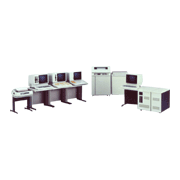The HITAC L-30, 50 and 70 Series were consolidated as a product line in 1983. These were series of office computers designed to meet a broad range of needs -- from core business tasks in mid-size companies to applications in departments of large firms.
The L-30/10 was the successor of the L-320/30H. This model was suitable as a standalone office computer for business processing at small business sites.
The L-50/10 and 20 were successors of the L-320/50H. They enabled simultaneous business processing involving shared master workstation files, by connecting up to a maximum of 8 (or 4, with the L-50/10) workstations to a master workstation. These machines also had a function for sharing printers and communication lines connected to the master workstation.
For the L-30 and 60 Series OS, it was possible to use Japanese language MS-DOS and MIOS3, the successor of the L-320/30H and 50H OS.
The L-70/20 enabled simultaneous business processing involving shared station controller files, printers, communication lines and other facilities. This was done by connecting up to a maximum of 15 workstations to a server called a "station controller". VLSI with a 32-bit architecture developed independently by Hitachi was used for the CPU. The system was equipped with MIOS7, which dramatically improved resource limitations (on memory capacity, file capacity and the number of workstations) while maintaining upward compatibility with MIOS3.
The L-30 could also be connected as a workstation for the L-50 and 70, and an L-50 master station could be connected as an L-70 workstation. This made it possible to achieve waste-free upgrading from the L-30 system to the L-50 system, and from the L-50 system to the L-70 system, to handle growth in the scale of work being done.


